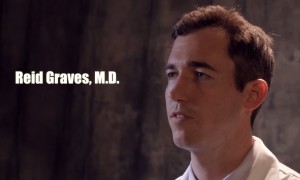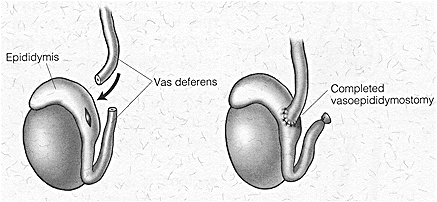What is a Vasectomy Reversal?
 It is a surgical procedure at which it reconnects the two ends of the vas deferens that has been cut during a Vasectomy operation. So it would return the natural flow of the sperms from the epididymis through the vas deferens out the urethra. This could only be done by highly skilled and experience surgeons, using specialize tool and apparatus.
It is a surgical procedure at which it reconnects the two ends of the vas deferens that has been cut during a Vasectomy operation. So it would return the natural flow of the sperms from the epididymis through the vas deferens out the urethra. This could only be done by highly skilled and experience surgeons, using specialize tool and apparatus.
Two Types of Vasectomy Reversal
Before any operation is done, it is very important to test the vas deferens vasal fluid first, because this will determine what type of Vasectomy Reversal will be performed. Since the testicle still continues to produce sperm even after a vasectomy surgery, the vasal fluid is tested for sperm. Under a light microscope, if the fluid contains a sperm whole or incomplete the standard procedure will be Vasovasostomy. This simply reconnects the separated ends of the vas deferens, which easily restores the flow of sperm with any complicated surgery. Worst case scenario will be that there no sperm present in the vasal fluid test result, this means that a “blow out” or rupture has occurred in the epididymis tubule, the weakest point in the system. It usually happens if the pressure in the tubule becomes greater than the resistance in the wall of the tubule. And this can develop a second obstruction deep in the epididymis which can make the vasectomy more difficult to reverse. A vasoepididymostomy procedure is needed for this scenario, a bypass from the blockage means connecting the epididymis directly to the vas deferens, allowing the sperm to flow once again in the urethra. This procedure is more complicated since the epididymal tubule is much smaller (0.3 mm diameter) than the vas deferens (3 mm diameter). So connecting both ends of the tubules requires skills and years of experience. See the attached image for reference:
I. Vasovasostomy

II. Vasoepididymostomy

The Surgery
Local anesthesia is used, with or without sedation, but sedation is preferred as to make the patient relax and still during the surgery. After the anesthesia, a standard operating procedure to prevent infections, a simple clean-up for the scrotum, washing with soap and water, and then drying it. The Patient is positioned laying with the back on the table and legs spread open, just like when a woman is giving birth. Then a small, 1–2 cm incision will be made in the upper scrotum on each side to expose the vas deferens. Again depending on the result of the test above, it is then cut precisely in half, both above and below the vasectomy site. A special bipolar microcautery is used to properly control any bleeding. One end of the vas deferens, termed the abdominal end, is inspected and flushed with salt solution to ensure that it is not blocked as it courses from the Prostate. Both ends of the tubules will be stitched together by a suture that is thinner than a human hair. Closing the gap between the tubules, and sewn with a special locking method prevent leaking fluids from it. The patient will be patched up and will be ready to go home. The procedure is generally done on a scheduled basis. The actual operating time can range from 1–4 hours, depending on the anatomical complexity, skill of the surgeon and the kind of procedure performed. Any complications like infections or bleedings will not likely occur, since the incisions made are very small. Infection is only present if you develop a fever, if the wound is inflamed and painful and there is existing pus. Other severe complications included are scrotal hematoma, granulomas and compartment syndrome, but these are very rarely diagnose. Success rate are based on patency rate, or return of some moving sperm to the ejaculate after vasectomy reversal, and pregnancy rates. With survey result of 95% of men who had vasovasostomy had motile sperm 1 year after vasectomy reversal.
Stitching

For those who had Vasectomy, fear not, for this is reversible. With the new age surgery called Vasectomy reversal, this can be undone. With the right set of tools and skills of a surgeon the success rate is likely. There are many who claimed they have the best equipment in the business, but tools are not enough without the surgeon who use them. Whatever type of procedure you had, rest assured, this is a very safe surgery, recommended for those who had vasectomy.
If you have questions, don’t hesitate to contact us. Our staff will gladly entertain you.
